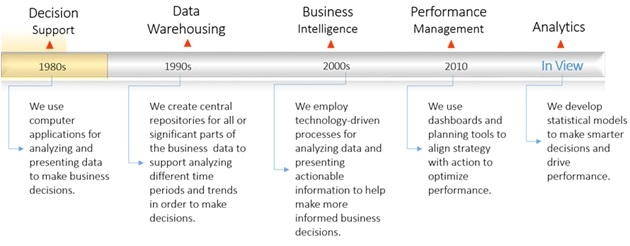Without a doubt, data and analytics have become central to every organization's business strategy.
In his book Competing on Analytics: The New Science of Winning, Tom Davenport claims that to be successful, a company needs to have strong analytics. He posits that those who are competitive in their analytics approach use data and analysis capabilities to discern what customers want, how much they're willing to pay, and what keeps them loyal.
He goes so far as to prescribe key steps for becoming an analytics competitor: have a champion at the top, create a single analytics initiative, establish an analytics culture, hire the right people, and use the right technology.
Davenport's advice is good. The challenge is how to implement it.
How do you effectively analyze the ever-growing amount of data? Between 2015 and 2020, the number of data sources analyzed will jump 83%, bringing the overall 10-year growth total to 120%, according to the 2015 Salesforce State of Analytics study.
No company can boil the ocean. Therefore, to be successful, it will be critical that you look at your digital marketing data and performance analytics through the lens of how to serve a business purpose.
When you review the journey of analytics, you can see that it's always been about making business decisions based on fact and insight that's based on data (see chart). Yet, according to CMOsurvey.org, less than one-third of business initiatives use digital marketing analytics.

Digital marketing analytics should answer the 'What'
The MarketingProfs article "How to Apply the Golden Circle to Marketing" explains how important it is to start with the question "Why?" However, in the case of analytics, you should start by asking "What?"
In other words, "What business decision does the organization need to make?"
Put another way: Business purpose is the beacon for your analytics.
Consider, therefore, how well Marketing can use its data and analytical muscle to answer these kinds of questions:
- Which customers are buying? Where can we expand our share of wallet? What offers should we make, and to which customers?
- Are any customers at risk? Which ones? What can we change to reduce customer risk? Can we improve customer preference?
- How are our marketing initiatives performing today? How about in the long run? What can we do to improve them?
- Where are our best market opportunities? Where are prospective customers spending their time and money?
- How does our marketing compare with our competitors'? Where are competitors spending their time and money? Are they using channels that we aren't?
- What should we do next? Are our marketing resources properly allocated? Are we devoting time and money to the right channels? How should we prioritize our investments for next year?
When Marketing uses digital analytics to bring the answers to these questions to the table, the department suddenly becomes more relevant, essential, influential, and valuable to an enterprise.
Focus your analytics with these three capabilities
You've decided that you're ready to be a more data-driven, analytically inclined marketing organization. To help you manage what can be a daunting undertaking, we recommend addressing these three capabilities first:
1. What's important should get done
First, you have to believe that data, analytics, and data-driven decision making is important. If you do, then your organization needs to integrate data and digital marketing analytics into the overall organization's strategy and processes. Doing so will most likely require investing in a critical mass of marketing analysts within the organization.
2. Have a plan of action to answer 'What'
You will need a plan for how you will use analytics to influence processes, performance, investments, and revenue opportunities. Move only those analytics initiatives forward that will answer "What": what customers, what markets, what solutions, what experiences, what processes, what channels, what content. Well, you get the idea.
3. Build an arsenal of tools and skills
At a minimum, your arsenal should include the following:
- The skills and tools that support data for exploration and preparation.
- The processes and rules for data management. For example, it is important to understand the way data will be gathered, the way it will be formatted, the characteristics and quality of the data, and the systems it will be stored in.
- The data and analytics tools and competencies for modeling, model development, model deployment, management, and operationalizing. Make sure you have a solid marketing model library. The Salesforce study found that high performers are 6.4 times more likely than underperformers to increase analytics spend 50% or more over the next two years. The study further broke down the spending, noting that 50% of those dollars would go to tools and technology, a little over one-third would go to people/staffing, and another one-third or so to training.
* * *
Using data and digital marketing analytics to drive strategic business decisions will improve Marketing's effectiveness and efficiency. When you take the next step and begin to analyze the data, you will delve deeper into your customer base to understand their needs and make course adjustments to better reach your audience.
Helping orient your business toward an analytics-driven model as a marketer will not only help the company make more successful, data-supported business decisions but also add value to your function.
Becoming a data-to-action organization is not easy. It will require impressive strides toward a new marketing mindset as well as a sizable investment in your marketing team. Making these investments will ensure that everyone on your marketing team has the skills to go from data to insights and insights to action.
Want to know more? Check out the whitepaper on how digital marketing analytics can help fuel growth.
More Resources on Digital Marketing Analytics
Analytics on the Edge: Lessons in Transforming Data's Impact [B2B Backstage]
Five Web Analytics Tools to Help You Optimize and Measure Marketing ROI




